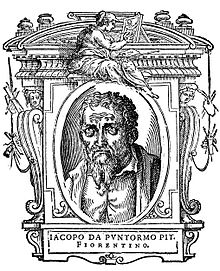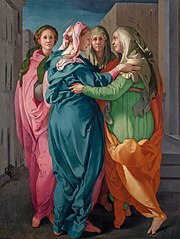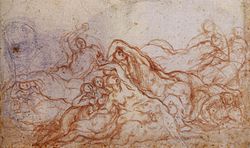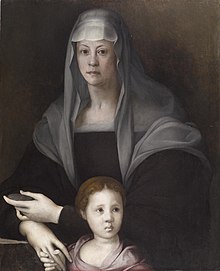| Pontormo | |
|---|---|
 Illustration from Lives of the Most Excellent Painters, Sculptors, and Architects by Giorgio Vasari, 1568 edition Illustration from Lives of the Most Excellent Painters, Sculptors, and Architects by Giorgio Vasari, 1568 edition | |
| Born | Jacopo Carucci May 24, 1494 Pontorme near Empoli, Republic of Florence |
| Died | January 2, 1557(1557-01-02) (aged 62) Florence, Republic of Florence |
| Nationality | Italian |
| Known for | Painting |
| Notable work | The Deposition from the Cross |
| Movement | Mannerism |
Jacopo Carucci or Carrucci (IPA: [ˈjaːkopo ka(r)ˈruttʃi]; May 24, 1494 – January 2, 1557), usually known as Jacopo (da) Pontormo or simply Pontormo (IPA: [ponˈtormo]), was an Italian Mannerist painter and portraitist from the Florentine School. His work represents a profound stylistic shift from the calm perspectival regularity that characterized the art of the Florentine Renaissance. He is famous for his use of twining poses, coupled with ambiguous perspective; his figures often seem to float in an uncertain environment, unhampered by the forces of gravity.
Biography and early work
Jacopo Carucci was born at Pontorme (then known as Pontormo or Puntormo), near Empoli, to Bartolomeo di Jacopo di Martino Carrucci and Alessandra di Pasquale di Zanobi. Vasari relates how the orphaned boy, "young, melancholy, and lonely", was shuttled around as a young apprentice:
Jacopo had not been many months in Florence before Bernardo Vettori sent him to stay with Leonardo da Vinci, and then with Mariotto Albertinelli, Piero di Cosimo, and finally, in 1512, with Andrea del Sarto, with whom he did not remain long, for after he had done the cartoons for the arch of the Servites, it does not seem that Andrea bore him any good will, whatever the cause may have been.
 Visitation, 1514–1516; Fresco; 392 x 337 cm; SS. Annunziata, Florence
Visitation, 1514–1516; Fresco; 392 x 337 cm; SS. Annunziata, Florence Visitation, 1528–29, Church of San Francesco e Michele, Carmignano
Visitation, 1528–29, Church of San Francesco e Michele, Carmignano
Pontormo painted in and around Florence, often supported by Medici patronage. A foray to Rome, largely to see Michelangelo's work, influenced his later style. Haunted faces and elongated bodies are characteristic of his work. An example of Pontormo's early style is a fresco depicting the Visitation of the Virgin and St Elizabeth, with its dancelike, balanced figures, painted from 1514 to 1516.
This early Visitation makes an interesting comparison with his painting of the same subject which was done about a decade later, now housed in the parish church of St. Michael Archangel in Carmignano, about 20 km west of Florence. Placing these two pictures together—one from his early style, and another from his mature period—throws Pontormo's artistic development into sharp relief. In the earlier work, Pontormo is much closer in style to his teacher, Andrea del Sarto, and to the early sixteenth-century renaissance artistic principles. For example, the figures stand at just under half the height of the overall picture, and though a bit more crowded than true high renaissance balance would prefer, at least are placed in a classicizing architectural setting at a comfortable distance from the viewer. In the later work, the viewer is brought almost uncomfortably close to the Virgin and St. Elizabeth, who drift toward each other in clouds of drapery. Moreover, the clear architectural setting that is carefully constructed in the earlier piece has been completely abandoned in favour of a peculiar nondescript urban setting.

The Joseph canvases (now in the National Gallery in London) offer another example of Pontormo's developing style. Done around the same time as the earlier Visitation, these works (such as Joseph in Egypt, at left) show a much more mannerist leaning. According to Giorgio Vasari, the sitter for the boy seated on a step is his young apprentice, Bronzino.
In the years between the SS Annunziata and San Michele Visitations, Pontormo took part in the fresco decoration of the salon of the Medici country villa at Poggio a Caiano (1519–20), 17 km NNW of Florence. There he painted frescoes in a pastoral genre style, very uncommon for Florentine painters; their subject was the obscure classical myth of Vertumnus and Pomona in a lunette.

In 1522, when the plague broke out in Florence, Pontormo left for the Certosa di Galluzzo, a cloistered Carthusian monastery where the monks followed vows of silence. He painted a series of frescoes, now quite damaged, on the passion and resurrection of Christ. These frescoes reveal especially strongly the influence of Albrecht Dürer's engravings, which often provided inspiration to Pontormo after he returned to Florence.
Main works in Florence

The large altarpiece canvas for the Brunelleschi-designed Capponi Chapel in the church of Santa Felicita, Florence, portraying The Deposition from the Cross (1528), is considered by many Pontormo's surviving masterpiece.
The figures, with their sharply modelled forms and brilliant colours, are united in an enormously complex, swirling ovular composition, housed by a shallow, somewhat flattened space. Although commonly known as The Deposition from the Cross, there is no actual cross in the picture. The scene might more properly be called a Lamentation or Bearing the Body of Christ. Those who are lowering (or supporting) Christ appear as anguished as the mourners. Though they are bearing the weight of a full-grown man, they barely seem to be touching the ground; the lower figure in particular balances delicately and implausibly on his front two toes. These two boys have sometimes been interpreted as angels, carrying Christ in his journey to Heaven. In this case, the subject of the picture would be more akin to an Entombment, though the lack of any discernible tomb disrupts that theory, just as the lack of cross poses a problem for the Deposition interpretation. Finally, it has also been noted that the positions of Christ and the Virgin seem to echo those of Michelangelo's Pietà in Rome, though here in the Deposition mother and son have been separated. Thus in addition to elements of a Lamentation and Entombment, this picture carries hints of a Pietà. It has been speculated that the bearded figure in the background at the far right is a self-portrait of Pontormo as Joseph of Arimathea. Another unique feature of this particular Deposition is the empty space occupying the central pictorial plane as all the Biblical personages seem to fall back from this point. It has been suggested that this emptiness may be a physical representation of the Virgin Mary's emotional emptiness at the prospect of losing her son.

On the wall to the right of the Deposition, Pontormo frescoed an Annunciation scene (at left). As with the Deposition, the artist's primary attention is on the figures themselves rather than their setting. Placed against white walls, the Angel Gabriel and Virgin Mary are presented in an environment that is so simplified as to almost seem stark. The fictive architectural details above each of them, are painted to resemble the gray stone pietra serena that adorns the interior of Santa Felicità, thus uniting their painted space with the viewer's actual space. The startling contrast between the figures and ground makes their brilliant garments almost seem to glow in the light of the window between them, against the stripped-down background, as if the couple miraculously appeared in an extension of the chapel wall. The Annunciation resembles his above-mentioned Visitation in the church of San Michele at Carmignano in both the style and swaying postures.
Vasari tells us that the cupola was originally painted with God the Father and Four Patriarchs. The decoration in the dome of the chapel is now lost, but four roundels with the Evangelists still adorn the pendentives, worked on by both Pontormo and his chief pupil Agnolo Bronzino. The two artists collaborated so closely that specialists dispute which roundels each of them painted.
This tumultuous oval of figures took three years for Pontormo to complete. According to Vasari, because Pontormo desired above all to "do things his own way without being bothered by anyone," the artist screened off the chapel so as to prevent interfering opinions. Vasari continues, "And so, having painted it in his own way without any of his friends being able to point anything out to him, it was finally uncovered and seen with astonishment by all of Florence..."
A number of Pontormo's other works have also remained in Florence; the Uffizi Gallery holds his mystical Supper at Emmaus as well as portraits.
Many of Pontormo's well-known canvases, such as the early Joseph in Egypt series (c. 1515) and the later Martyrdom of St Maurice and the Theban Legion (c. 1531) depict crowds milling about in extreme contrapposto of greatly varied positions.
His portraits, acutely characterized, show similarly Mannerist proportions.
Lost or damaged works



Many of Pontormo's works have been damaged, including the lunettes for the cloister in the Carthusian monastery of Galluzo. They now are displayed indoors, although in their damaged state.
Perhaps most tragic is the loss of the unfinished frescoes for the choir of the Basilica of San Lorenzo, Florence which consumed the last decade of his life. His frescoes depicted a Last Judgment day composed of an unsettling morass of writhing figures. The remaining drawings, showing a bizarre and mystical ribboning of bodies, had an almost hallucinatory effect. Florentine figure painting had mainly stressed linear and sculptural figures. For example, the Christ in Michelangelo's Last Judgment in the Sistine Chapel is a massive painted block, stern in his wrath; by contrast, Pontormo's Jesus in the Last Judgment twists sinuously, as if rippling through the heavens in the dance of ultimate finality. Angels swirl about him in even more serpentine poses. If Pontormo's work from the 1520s seemed to float in a world little touched by gravitational force, the Last Judgment figures seem to have escaped it altogether and flail through rarefied air.
In his Last Judgment, Pontormo went against pictorial and theological tradition by placing God the Father at the feet of Christ, instead of above him, an idea Vasari found deeply disturbing:
But I have never been able to understand the significance of this scene, ... I mean, what he could have intended to signify in that part where there is Christ on high, raising the dead, and below His feet is God the Father, who is creating Adam and Eve. Besides this, in one of the corners, where are the four Evangelists, nude, with books in their hands, it does not seem to me that in a single place did he give a thought to any order of composition, or measurement, or time, or variety in the heads, or diversity in the flesh-colours, or, in a word, to any rule, proportion or law of perspective, for the whole work is full of nude figures with an order, design, invention, composition, colouring, and painting contrived after his own fashion ...
Critical assessment and legacy
Vasari's Life of Pontormo depicts him as withdrawn and steeped in neurosis while at the centre of the artists and patrons of his lifetime. This image of Pontormo has tended to colour the popular conception of the artist, as seen in the film of Giovanni Fago, Pontormo, a heretical love. Fago portrays Pontormo as mired in a lonely and ultimately paranoid dedication to his final Last Judgment project, which he often kept shielded from onlookers. Yet as the art historian Elizabeth Pilliod has pointed out, Vasari was in fierce competition with the Pontormo/Bronzino workshop at the time when he was writing his Lives of the Most Excellent Painters, Sculptors, and Architects. This professional rivalry between the two bottegas could well have provided Vasari with ample motivation for running down the artistic lineage of his opponent for Medici patronage.

Perhaps as a result of Vasari's derision, or perhaps because of the vagaries of aesthetic taste, Pontormo's work was quite out of fashion for several centuries. The fact that so much of his work has been lost or severely damaged is a testament to this neglect, though he has received renewed attention from contemporary art historians. Indeed, between 1989 and 2002, Pontormo's Portrait of a Halberdier (at right), held the title of the world's most expensive painting by an Old Master.
Regardless of the veracity of Vasari's account, it is certainly true that Pontormo's artistic idiosyncrasies produced a style that few were able (or willing) to imitate, with the exception of his closest pupil Bronzino. Bronzino's early work is so close to that of his teacher, that the authorship of several paintings from the 1520s and '30s is still under dispute—for example, the four tondi containing the Evangelists in the Capponi Chapel.
Pontormo shares some of the mannerism of Rosso Fiorentino and of Parmigianino. In some ways, he anticipated the Baroque as well as the tensions of El Greco. His eccentricities also resulted in an original sense of composition. At best, his compositions are cohesive. The figures in the Deposition, for example, appear to sustain each other: removal of any one of them would cause the edifice to collapse. In other works, as in the Joseph canvases, the crowding makes for a confusing pictorial melee. It is in the later drawings that we see a graceful fusion of bodies in a composition which includes the oval frame of Jesus in the Last Judgement.
Anthology of works

Early works (until 1521)
| Painting | Date | Site | Link |
|---|---|---|---|
| Leda and the Swan (uncertain attribution) | 1512–1513 | Uffizi Gallery, Florence | |
| Apollo and Daphne | 1513 | Bowdoin College Museum of Art, Brunswick, Maine | |
| Holy Conversation | 1514 | San Luca Chapel, Santissima Annunziata, Florence | |
| Madonna and Child with the Infant St John the Baptist | c. 1514 | Whitfield Fine Art, London | |
| Episode of Hospital Life | 1514 | Accademia, Florence | |
| Veronica and the Image | 1515 | Medici Chapel, Santa Maria Novella, Florence | |
| Visitation | 1514–1516 | Santissima Annunziata, Florence | |
| Lady with Basket of Spindles (attributed to Andrea del Sarto) | 1516–1517 | Uffizi Gallery, Florence | |
| Marriage bedchamber panels for Pier Francesco Borgherini. (Two others by Francesco Bacchiacca) | |||
| Joseph reveals himself to his brothers | 1516–1517 | National Gallery, London | |
| Joseph Sold to Potiphar | 1516–1517 | National Gallery, London | |
| Joseph's Brothers Beg for Help | 1515 | National Gallery, London | |
| Pharaoh with his Butler and Baker | 1516–1517 | National Gallery, London | |
| Joseph in Egypt | 1517–1518 | National Gallery, London | |
| *St. Quentin (Also attributed to Giovanni Maria Pichi) | 1517 | Pinacoteca comunale, Sansepolcro | |
| Portrait of Furrier | 1517–1518 | Louvre, Paris | |
| St Jerome & St Francis | 1518 | Whitfield Fine Art, London | |
| Pucci Altarpiece | 1518 | San Michele Visdomini, Florence | |
| Portrait of Musician | 1518–1519 | Uffizi Gallery, Florence | |
| St Anthony Abbott | 1518–1519 | Uffizi Gallery, Florence | |
| Portrait of Cosimo the Elder | 1518–1519 | Uffizi Gallery, Florence | |
| John the Evangelist & the Archangel Gabriel | 1519 | Church of S. Michele, Empoli | |
| Adoration of the Magi | 1519–1521 | Palazzo Pitti, Florence | |
| Vertumnus and Pomona | 1519–1521 | Villa Medici, Poggio a Caiano | |
| Study of Man's Head (Drawing) | Metropolitan Museum of Art, New York City | ||
| Portrait of Gentleman with book and gloves | 1540-1541 | Cerruti Collection, Castello di Rivoli Museo d’Arte Contemporanea, Rivoli- Turin |
Mature works (1522–30)
| Painting | Date | Site | Link |
|---|---|---|---|
| Mary and Child with Four Saints | 1520–1530 | Metropolitan Museum, New York City | |
| Portrait of two friends | c. 1522 | Fondazione Giorgio Cini, Venice | |
| Madonna with Child & Two Saints (Bronzino?) | c. 1522 | Uffizi Gallery, Florence | |
| Holy Family with St John | 1522–1524 | Hermitage Museum, St Petersburg | |
| Madonna with Child & St John (Attributed to Rosso Fiorentino) | 1523–1525 | Uffizi Gallery, Florence | |
| Prayer in Gesthemane (copies by Jacopo da Empoli) | 1523–1525 | Certosa di Galluzzo | |
| Walk to Calvary | 1523–1525 | Certosa di Galluzo | |
| Christ before Pilate | 1523–1525 | Certosa di Galluzzo | |
| Deposition | 1523–1525 | Certosa di Galluzzo | |
| Resurrection | 1523–1525 | Certosa di Galluzzo | |
| Supper in Emmaus | 1525 | Uffizi Gallery, Florence | |
| Study of a Carthusian Monk (Drawing) | 1525 | Uffizi Gallery, Florence | |
| Madonna and child & two angels | 1525 | San Francisco Museum of Art, San Francisco | |
| Portrait of young man in pink | 1525–1526 | Pinacoteca Communale, Lucca | |
| Tabernacle of San Giuliano, Boldrone, Crucifix with Madonna & St. John, and Sant'Agostino | 1525–1526 | Accademia, Florence | |
| Birth of St. John Baptist | 1526 | Uffizi Gallery, Florence | |
| Penitent Saint Jerome | 1526–1527 | Lower Saxony State Museum, Hanover | |
| Madonna with Child & St John (Bronzino?) | 1526–1528 | Palazzo Corsini, Florence | |
| Madonna with Child & St John | 1527–1528 | Uffizi Gallery, Florence | |
| Matthew, Luke, & John (Mark painted by Bronzino) | 1525–1526 | Santa Felicita, Capponi Chapel, Florence. | |
| Deposition | 1526–1528 | Santa Felicita, Capponi Chapel, Florence. | |
| Annunciation | 1527–1528 | Santa Felicita, Capponi Chapel, Florence | |
| Portrait of Francesca Capponi, as St. Mary Magdalen | 1527–1528 | Whitfield Fine Art, London | |
| Visitation | 1528–1529 | Church of San Francesco e Michele, Carmignano | |
| Virgin and Child with Saint Anne and Four Saints | 1528–1529 | Louvre Museum, Paris | |
| Portrait of a Halberdier | 1528–1530 | J. Paul Getty Museum, Los Angeles | |
| The Ten Thousand Martyrs | 1529–1530 | Palazzo Pitti, Florence | |
| Portrait of a man in a red cap | 1530 | National Gallery, London |
Late works (after 1530)
| Painting | Date | Site | Link |
|---|---|---|---|
| Martyrdom of San Maurizio and the Theban Legions (Pontormo & Bronzino) | 1531 | Uffizi Gallery, Florence | |
| Noli me Tangere (Bronzino?) | 1531 | Casa Buonarroti, Florence | |
| Portrait of lady in red with puppy, (Bronzino?) | 1532–1533 | Städelsches Kunstinstitut, Frankfurt | |
| Venus and Cupid | 1532–1534 | Galleria dell'Accademia, Florence | |
| Portrait of Alessandro de' Medici | before December 1535 | Philadelphia Museum of Art, Philadelphia | |
| Portrait of Alessandro de' Medici | c. 1534–1535 | Art Institute of Chicago, Chicago | |
| Expulsion of Adam and Eve | c. 1535 | Uffizi Gallery, Florence | |
| Study for the Three Graces (Drawing) | 1535 | Uffizi Gallery, Florence | |
| Portrait of Maria Salviati de' Medici and Giulia de' Medici (Painting) | c. 1539 | Walters Art Museum, Baltimore | |
| Portrait of Niccolò Ardinghelli | National Gallery, Washington, D.C. | ||
| Portrait of Maria Salviati | 1543–1545 | Uffizi Gallery, Florence | |
| Sacrificial Scene | c. 1545 | Capodimonte Museum, Naples | |
| My Book (Pontormo's Diary) | 1554–1556 | National Library, Florence | |
| Portrait of Pontormo (Bronzino) | |||
| St. Francis (Drawing) | Museum of Fine Arts, Boston | ||
| San Lorenzo (Fresco cartoons) |
See also
References
- "Pontormo: Miraculous Encounters". The Morgan Library & Museum. April 4, 2018. Retrieved November 9, 2018.
- The Morgan Library and Museum, Jacopo Pontormo, Bruce Edelstein, Davide Gasparotto, Giada Damen, and Cristina Gnoni Mavarelli. 2018. Miraculous Encounters: Pontormo from Drawing to Painting. Los Angeles: The J. Paul Getty Museum. p. 109. ISBN 978-1-60606-589-1
- One attempt at defining mannerist art is to characterize it as art that follows art rather than art that follows nature, or life. Though Freedberg did not classify Pontormo as a strictly maniera painter, if we accept that the Deposition does hold a quotation from Michelangelo's Pietà, then perhaps we can understand better how Pontormo fits in as a mannerist and into his own larger history of sixteenth-century art.
- Giorgio Vasari, The Lives of the Artists, tr. Julia Conaway Bondanella and Peter Bondanella (Oxford University Press, 1998), p. 409
- Still visible to the traveller Lassel in his travels through Italy, published 1698 , page 105.
- See "An Introduction to Vasari's Story" in Pontormo, Bronzino, and Allori: A Genealogy of Florentine Art (New Haven, CT: Yale University Press, 2001).
- "Portrait of Maria Salviati de' Medici with Giulia de' Medici". Walters Art Museum.
Further reading
- Krystof, Doris. Joseph Carrucci, known as Pontormo 1494–1557. Köln: Konemann, 1988. ISBN 3-8290-0254-8
- Keener, Chrystine. (2021). Pontormo's lost frescoes at San Lorenzo: political propaganda and dynastic symbolism /.
External links
- Pontormo's paintings and drawings illustrated
- Pontormo at Olga's Gallery
- Giorgio Vasari's Vita (in English)
- A diary of his last two years survives
- Pontormo. Pictures and Biography
- "Jacopo Carucci da Pontormo, his life and works", by Frederik Mortimer Clapp, Oxford University Press, 1916 (at Internet Archive)
- Official website of the Church of San Michele Arcangelo, Carmignano, home of the Visitation